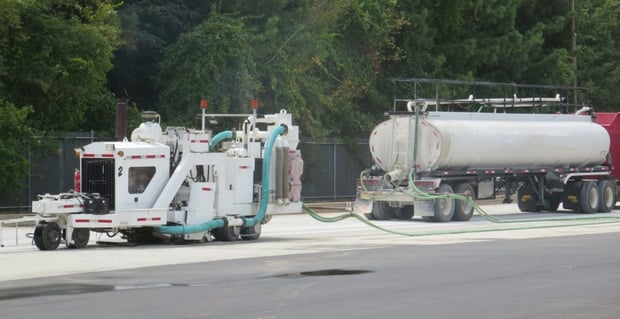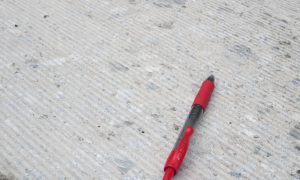Save time, money and the environment on your next pavement rehabilitation project.
By Daniel E. Wilson, P.E.

A diamond grinding process can renew the surface of distressed concrete pavement.
Diamond grinding is a concrete pavement restoration process that renews a worn or slightly irregular surface. Diamond grinding can potentially remove or reduce some pavement deficiencies such as joint faults resulting from minor pavement settlement, worn pavement from wheel rutting, warped slabs, and a rough surface texture.
Diamond grinding pavement establishes a smoother surface with a better ride quality. Diamond grinding is a procedure where a machine (pictured above) powers a rotating cutting head across the pavement surface in the direction the machine travels. The grinding head consists of a series of closely spaced, diamond-tipped saw blades and spacers that form the cutting head. The grinding head is typically 3’ to 4’ wide, and 12” to 18” in diameter, and consists of 50 to 60 saw blades per foot of drumhead length. The desired surface texture is a result of the number of blades, the thickness of the spacers, and the machine speed. These variables are project specific depending on the result the owner wishes to have and what the restoration is to achieve.
The operator adjusts the depth of the grinding to achieve the desired results, but it is generally a half-inch to a quarter-inch in depth. A vacuum system is contained on the machine to pick up the water that is used to cool the cutting head and the slurry produced during the grinding. The slurry is then either discharged adjacent to the pavement being ground or pumped into a tanker and taken off site to a proper disposal location.
Advantages
While not raising the pavement’s elevation, diamond grinding results in improved ride quality, noise reduction, and increased friction resistance. Decreasing the pavement irregularities restores ride quality, whether the irregularities are bumps or low areas in the pavement. Irregularities can be the result of surface wear, construction damage, environmental effects, prior pavement repairs or settlement. Pavements that have irregularities in the commercial or industrial sector affect the ability of the facility to safely transfer goods and products by fork truck, pallet jacks, spotter vehicles or over the road haulers. Although noise reduction and increased friction resistance are not typical benefits that a commercial or industrial customer is looking for, these are desired benefits for many highway projects.
Many sites are in a condition where the pavement grades cannot be raised with an asphalt pavement overlay because of drainage concerns or fixed dock and loading zone heights. Diamond grinding will typically remove only a quarter-inch in pavement height, thereby maintaining the existing drainage flow and required fixed heights at truck docks and loading zones.
Requirements
Not all concrete pavements are candidates for pavement restoration by diamond grinding. When considering diamond grinding, the conditions to study would include pavement surfaces with weak supporting soils and/or poor concrete materials, as well as pavements requiring a lot of repairs or containing high reinforcing steel in the slabs.
The pavement must have a good overall structural integrity, stable base and subbase materials to produce the desired results. Pavement irregularities such as scaling, spalling, and certain types of cracking should be carefully evaluated when considering diamond grinding.
Typically, the grinding operation should not encounter the reinforcing steel in the pavement due to the limited grinding depth on a typical project. The grinding operation may have to skip over sections if reinforcing steel is found so as to not risk damaging the cutting head.
Considerations
When existing conditions won’t allow for an asphalt overlay, a concrete pavement restoration process is the answer. Often, an overlay of asphalt on a concrete surface is not the best solution. Factors to consider are the potential for freeze/thaw cycles that can degrade the serviceability of the overlay reducing its life span, the stability of the concrete surface, concrete joint conditions, and the surface drainage slope.
The climate in many parts of the country is a deciding factor on whether asphalt is the right answer for concrete pavement rehabilitation. The effects of moisture and freeze/thaw cycles can cause reflective cracking, delamination, and joint deterioration. Concrete pavement with wider joints that have not been maintained through a jointsealing maintenance program will cause a higher degree of reflective cracking at a faster rate leading to surface delamination. In a milder climate that is typical of the southern states, reflective cracking is less of a concern.
Many times, designs of concrete pavements have a lower degree of surface slope than a corresponding asphalt surface. The lower surface slopes may not have the desired surface flow with an asphalt overlay, making diamond grinding a good choice. If the pavement construction includes a curb and gutter, and the surface drainage is towards the curbs, diamond grinding would be a good choice.
Restoration In Action
One of our recent projects involved concrete pavement restoration using diamond grinding. The facility was a large warehouse and distribution center. The project included 13,000 square yards of roadway and dock pavement over a 1,800-foot long section of the warehouse. The pavement had an asphalt overlay installed several years ago, which was showing signs of distress with large areas of delamination and reflective cracking.

Diamond grinding process improves the surface texture of concrete.
This site was a perfect candidate for restoration because:
• The pavement had valley drainage towards the main roadway.
• Curbs on the perimeter had pavement slopes towards the roadway center.
• The older overlay had affected the trailer heights at the loading docks.
• In the areas of delamination, the concrete pavement appeared sound and stable.
• The surface of the concrete pavement installed in the 1970s appeared to be in fair condition.
• The trailer landing gear was wearing through the asphalt surface to the concrete below.
• Full closure of many of the docks and the adjacent roadway was not an option.
Evaluation of pavement cores determined the existing asphalt and pavement thicknesses and the composition and stability of the base and subbase. The processes involved several phases in order to have the least possible amount of impact on the owner’s operations.
The process involved:
• Milling existing asphalt off the surface to expose original concrete pavement.
• Determining the limits of the pavement and joint repairs.
• Adjusting drainage structures to the new pavement elevation.
• Diamond grinding the pavement.
• Pavement marking.
• Joint and cracksealing.
Milling and diamond grinding were able to re-establish the proper drainage profile, drainage surface flow, and provide a better ride quality for trucks and spotter vehicles. The finished surface also allows the owner to begin a maintenance program on the joints in the concrete pavement that are now uncovered. A timely and consistent maintenance program is essential to any pavement to prolong service life.
